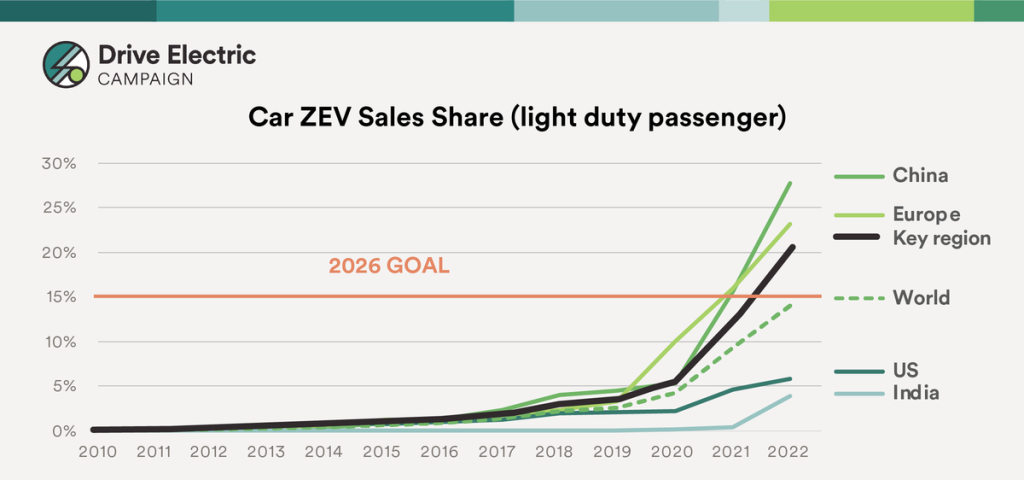“Are we there yet?” is a classic refrain of the family road trip, and increasingly a question that everyone – from journalists to economists to climate-concerned citizens – poses about the global transition from fossil fuel-powered polluting vehicles to clean electric vehicles (EVs) powered by increasing renewable electricity.
Transportation today contributes one-fifth of energy-related greenhouse gas emissions globally, with the vast majority coming from the more than one billion cars, trucks, buses, and two- and three-wheelers powered by oil. Getting the world on track to reduce these emissions at the speed and scale consistent with climate goals will be no small feat. Recent advancements in policy have brought us a long way — I’ve witnessed it since the early days of my career as an automotive engineer, to advising and implementing world-leading policies in California, and now directing the transportation program at ClimateWorks Foundation.
In late 2015, ClimateWorks and a number of partners came together to test an idea: philanthropy as a catalyst for conditions to tip the market toward cleaner vehicles. This global collaboration to accelerate the market, now known as the Drive Electric Campaign, supports research, engages policy-makers and businesses, and partners with communities like workers, health experts, and those who have been overburdened by tailpipe pollution for far too long.
When our team began to supercharge our efforts seven years ago, we knew that ambition was the route to turn ideas into implementation. Time and again, we have seen firsthand how ambition plus policy can galvanize large scale investment in electric transportation.
As with any journey, we needed signposts or indicators to know if we are on the right track. One way to think about the shift from polluting combustion to clean EVs is through the lens of innovation theory, or looking at the patterns and speed of how new technologies spread through society. The point at which the market moves beyond early adopters to the mass market as is required for scaled impact.
When we look through the lens of what is needed for a livable planet, we see that an accelerated adoption curve is essential to avoiding the worst impacts of the climate crisis. Together with expert partners, the Drive Electric Campaign developed models for what the adoption curve would need to look like for a thriving world.
One of our signposts then came into view: the year that 15% of new vehicles sold are zero-emission electric models. While not perfect, this tipping point indicates growing consumer awareness and confidence in the technology, increasing convenience such as infrastructure availability, and scaling investment in vehicle production and the supply chain.
When would we reach this milestone? The Drive Electric Campaign decided on a bold goal of a 15% average market share in 2026 within the biggest vehicle markets: China, the U.S., Europe, and India. Together, these markets account for more than 70% of current global vehicle demand. At the time the goal was set, the average global market share for EVs was less than 1%, and other forecasts estimated that such an ambitious level of market adoption wouldn’t be reached for decades.
Earlier this year, we connected with Drive Electric’s global network of partners to discuss the progress toward a 100% EV future. We’re thrilled to note that in 2022, the average of new passenger vehicle sales that were electric in the four key markets crossed the 15% threshold—we reached the milestone a remarkable four years ahead of our goal.
This is cause for celebration, and is absolutely encouraging. But as with anything, the devil’s in the details. While the average across the four major markets soared past our 15% goal, there is a wide variation across the markets, while other segments like trucks are still lagging.
Within the sales data, we can see the story unfolding of how to move markets toward a climate-aligned future with strong policies. Europe and China, have been setting ambitious policies such as carbon dioxide standards and zero-emission vehicle (ZEV) sales requirements that incentivize the market. Such policies motivate manufacturers to develop and offer more affordable EV models while providing confidence for others to make investments in EV charging and the supply chain.
The U.S., which suffered through four years of lax and even antagonistic policies under the previous administration, began to catch up last year with a reinstatement of stronger carbon dioxide standards for cars, billions of investments and incentives in EVs, and bold new policies such as the Advanced Clean Cars and Advanced Clean Truck policies spearheaded by U.S. states.
In India, an accelerated EV future looks more promising than ever due to the incredible progress made with national support and state-level policies. Currently, 90% of states in India have adopted or are in the final stages of establishing an EV policy—and it’s working. Leading states and territories like Delhi, Uttar Pradesh, and Maharashtra are starting to see a significant uptick in EV adoption for cars, two- and three-wheelers, and buses.
Importantly, these policies, and the resulting market acceleration, are occurring precisely in the regions where Drive Electric Campaign partners are most active. Our network is building political will, engaging government and business decision-makers, and providing technical assistance on the most effective actions.
We’re also seeing progress and a real desire to lead a zero-emission transportation future in Chile, Costa Rica, Kenya and many other countries beyond the four biggest vehicle markets. Partners of the Drive Electric Campaign are now working in over 100 countries to help “leapfrog” the transition from oil-combustion vehicles to cleaner electric transportation.
Just like the classic roadtrip saying goes; we’re not quite there yet. Achieving the milestone early shows that a coordinated philanthropic effort to shift the needle on ambition, policy, and investment works. Now we need to strengthen and expand this work more broadly, to ensure the benefits of the transition to much cleaner electric transportation can be enjoyed by all. Join us for the ride.
Read the full article here










